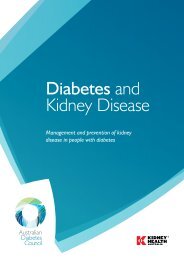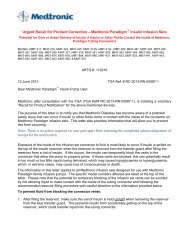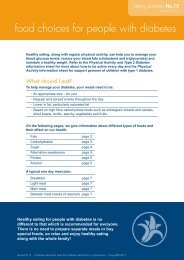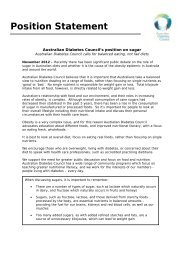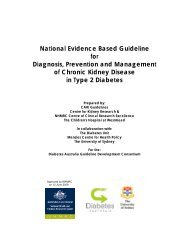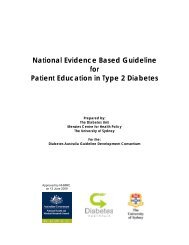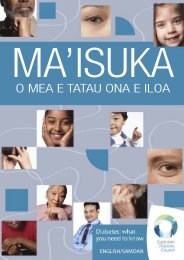Part 6: Detection and Prevention of Foot Problems in Type 2 Diabetes
Part 6: Detection and Prevention of Foot Problems in Type 2 Diabetes
Part 6: Detection and Prevention of Foot Problems in Type 2 Diabetes
You also want an ePaper? Increase the reach of your titles
YUMPU automatically turns print PDFs into web optimized ePapers that Google loves.
Background - Ulcer as a Risk Factor for AmputationObservational studies suggest that 6-43% <strong>of</strong> people with diabetes who have a footulcer eventually progress to amputation (Bild et al, 1989; Apelqvist et al, 1994;Larsson et al, 1995; Moss et al, 1996). Retrospective studies suggest that lowerextremity ulcers precede 71-85% <strong>of</strong> first (Reiber et al, 1992; Larsson et al, 1995;Moss et al, 1996) or second amputation (Larsson et al, 1998). While the presence <strong>of</strong> acurrent ulcer leads to an <strong>in</strong>creased risk <strong>of</strong> amputation, it is important to know the level<strong>of</strong> risk <strong>and</strong> whether a healed ulcer is also a risk factor <strong>in</strong> the assessment <strong>of</strong> the feet <strong>of</strong> aperson with diabetes for ongo<strong>in</strong>g monitor<strong>in</strong>g <strong>and</strong> preventative <strong>in</strong>tervention. It hasbeen observed that the most likely site for plantar ulceration <strong>in</strong> neuropathic feet is atthe location <strong>of</strong> a previous ulcer (Sims et al, 1988).While sophisticated measurements are sometimes used to assess the high risk foot, thehistory <strong>of</strong> an ulcer or the detection <strong>of</strong> a current ulcer by physical exam<strong>in</strong>ation are bothrisk factors capable <strong>of</strong> detection by all primary care health pr<strong>of</strong>essionals. Preventativeaction can then be <strong>in</strong>stituted <strong>in</strong> an easily identified high risk group (Apelqvist et al,1993).Evidence - Ulcer as a Risk Factor for AmputationA healed diabetic foot ulcer is an <strong>in</strong>dicator <strong>of</strong> high risk for recurrent ulceration<strong>and</strong> amputationA UK prospective study followed 63 neuropathic people (median age 62 years <strong>and</strong>median duration <strong>of</strong> diabetes 17 years) with plantar callus <strong>and</strong> high plantar footpressures. After 22 months follow-up previous ulceration proved to be the highest riskfactor for the development <strong>of</strong> a new foot ulcer with a RR <strong>of</strong> 56.8 (p=0.00001) (Murrayet al, 1996).A 14 year prospective study followed 984 diabetic <strong>in</strong>dividuals (mean age 64.4 years<strong>and</strong> a duration <strong>of</strong> diabetes 10.9 years) from a population based cohort fromWiscons<strong>in</strong>, US. A history <strong>of</strong> foot ulceration was associated with the highest OR <strong>of</strong>3.56 (CI 1.84-6.89, p≤0.0005) for amputation <strong>in</strong> a multivariate logistic regressionmodel. Male gender was also a risk factor (OR 2.66 [CI 1.49-4.76], p




